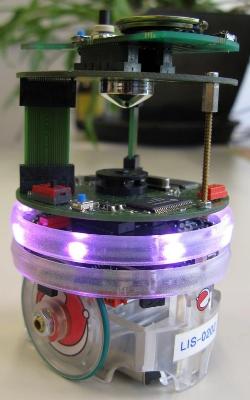Dario Floreano and Steffen Wischmann from EPFL and Laurent Keller from the University of Lausanne (UNIL) conducted a joint research project, which showed that communication systems can develop differently in the same species and in the same environment.
 A robot equipped with camera and wheels
A robot equipped with camera and wheels
The study, which was performed using robots, will allow researchers to gain a better insight about communication within the animal kingdom.
The scientists tracked the evolution of communication in 100 groups of 20 homogenous robots by equipping them with a camera that was capable of detecting the surroundings. Wheels and a ring were also added to the robots, allowing them to produce luminous signals of varied colors. The robots had to detect a source of virtual food that can be seen only when they stumble upon it. The robots’ actions were guided by a “neural network”, which in turn was controlled by genes.
The study indicated that robots can quickly acquire a communication system which allows them to send data to their peers about food location. According to the given populations, two different communication systems evolved. The simplest mechanism, which utilizes one color to specify the food location proved more effective than the system utilizing dual colors.
Another study showed that within a competition context, when robots were confronted with other groups of robots, it was the two-color strategy that emerged victorious, despite the efficiency of the single-color strategy.
The study was published in the magazine ‘Proceedings of the National Academy of Sciences of the United States’. It demonstrated that communication strategies can evolve in varied ways through generations within the same surroundings.